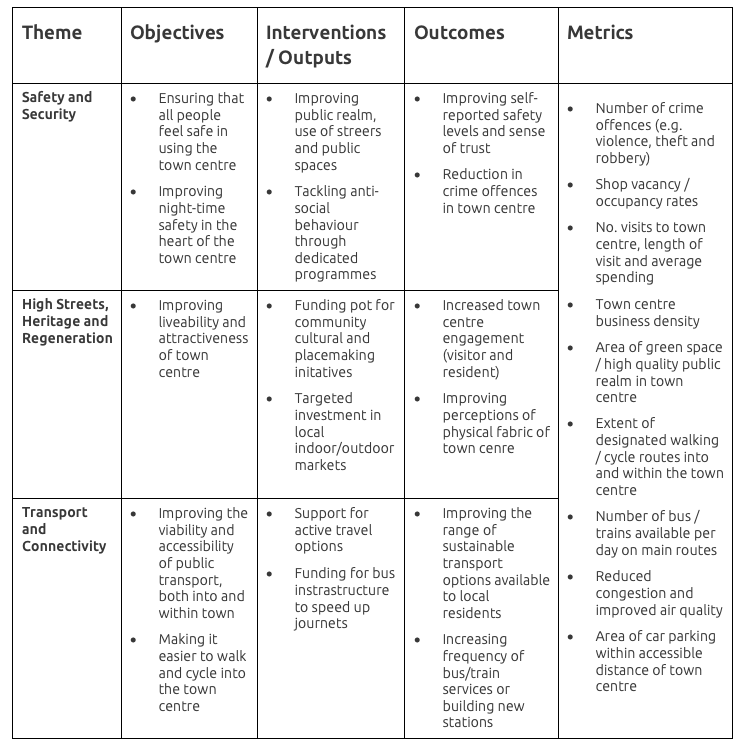Making the most of the Three Investment Themes
April 2024 | Matt Gwelo
The £20m endowment-style funding provided to Town Boards through the Long-Term Plan for Towns programme to allocate across three investment themes over the next decade represents a place-based approach to levelling-up which is forward-looking and agile in its approach. Whilst there is no requirement on how towns utilise funding across the three investment themes, the guidance states that DLUHC would expect to see at least one intervention per theme, unless towns justify an alternate approach.
The three broad investment themes identified by DLUHC provide a flexible framework for towns to identify and develop a variety of capital and revenue interventions that address local priorities. To streamline the delivery of interventions, a comprehensive list of ‘on-menu’ policy interventions has been identified by DLUHC that have already been assessed as having a strong case for investment, value for money and Benefit Cost Ratio. Town Boards are also able to pursue ‘off-menu’ interventions to respond directly to local issues. These will require an outline business case.
What are the investment themes?
The three investment themes look to tackle some of the complex social and economic challenges facing left-behind towns across Britain as a part of the Levelling-Up agenda
Safety and Security
In alignment with the recently published Anti-Social Behaviour Action Plan, policies within this theme will seek to make town centres more attractive by reducing crime and improving safety for those using public areas. Preventative measures include security infrastructure to discourage perpetrators and community outreach activities to tackle root issues.
High Streets, Heritage and Regeneration
Focusing on the vital role that our high streets play in defining the perceptions and success of our town centres, this theme looks to address neglect in our towns, including that exacerbated by Covid-19 and changes to working patterns.
A large range of policy options are available to improve the vibrancy of town centres, from developing public realm and green spaces, to growing the arts, culture and heritage offer, to supporting civil society and leisure activities. It will be crucial to understanding the links between these interventions and driving wider economic and social benefits, as well as algining them with wider work such as housing initatives.
Transport and Connectivity
As well as making places safer and more vibrant, it is necessary to ensure that as many people, businesses and community groups as possible have access to the opportunities and amenities within towns. As such, interventions to improve the viability and accessibility of public transport, walking and cycling options, parking and digital connectivity will need to form a part of a Long-Term Plan where transport and connectivity is a critical barrier to employment and housing growth, town centre footfall and access to key services.
Interventions across the key themes
To respond to local challenges and opportunities, Town Boards must be able to effectively prioritise interventions across the three investment themes. To achieve this, Town Boards must identify the most pressing issues facing their towns that can be tackled successfully by the policy interventions available to them.
By taking a pragmatic approach to designing interventions, towns can ensure that their funding is well spent to tackling the most urgent issues. At Gencon, we have found that a well-designed logic model can be a great tool for keeping focus on identifying problems and identifying genuine solutions.
Below is a high-level example of what a logic chain might look like for a couple of ‘on-menu’ interventions across each of the investment themes, linking together overall objectives with interventions, outcomes and metrics:

Top tips: Planning Effective Interventions
Developing effective interventions across the investment themes will be crucial to ensuring that Long-Term Plans have a genuine and long-lasting impact upon towns. Here are three top tips for developing an effective suite of interventions across the investment themes:
- Take an evidence-based approach to prioritising issues and maximising the value of interventions. Given the breadth of the investment themes and wide array of issues facing local authorities, it will be tempting to try to solve a high number of problems facing your town. Town Boards will need to be disciplined and pragmatic in agreeing a focused set of priorities and interventions which, informed by a robust evidence base and stakeholder engagement, seek to maximise value for money in addressing the most important local issues.
- Understand the links, core assumptions and dependencies between objectives, outputs, outcomes and impacts. Genecon is well-versed in co-developing robust theories of change and logic models with stakeholders that clearly set out how investments will create positive impacts and deliver on local objectives. This will help ensure that interventions offer excellent good value for money and inform future monitoring and evaluation.
- Align with the recommended list of policy interventions – unless there is a strong strategic case for divergence. Proposals for interventions which deviate from the recommended list will require an outline business case, and therefore require stronger strategic case for taking the project forward. For some places, this will be worth the effort – particularly in supporting larger, long-term projects. Genecon will draw on its strong history of success of designing and drafting OBCs to help deliver key local priorities.
< Back to News, Views & Insights
More articles

Making the most of the Three Investment Themes
24th April 2024The £20m endowment-style funding provided to Town Boards through the Long-Term Plan for Towns programme to allocate across three investment themes over the next decade represents a place-based approach to levelling-up which is forward-looking and agile in its approach. Whilst there is no requirement on how towns utilise funding across the three investment themes, the […]

What does art mean to you?
15th April 2024Many people think of art as painting, drawing – the visual arts you go to a gallery to see. But art is much more than that – its any object or experience that communicates an idea, an emotion, or a view of the world, and it can take many forms. ‘Art isn’t just what we […]

Empowering Towns: Navigating Long-Term Plans and Local Authority Challenges
10th April 2024Completing a robust Long-Term Plan for Towns (LTPFT) submission to government in a relatively short space of time is very challenging. Allocating £20m of “endowment style” funding over a 10-year period, across a town, and split between three themes (Safety and Security; High streets, Heritage and Place; and, Connectivity and Transport) will require some tough decisions, […]